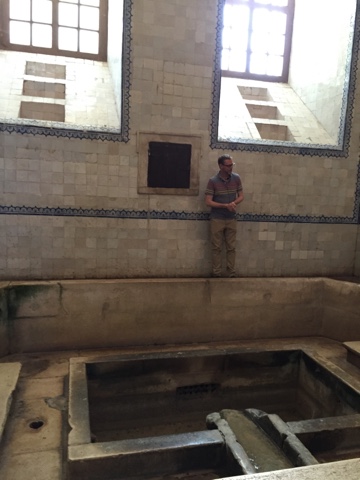Today provided us with another look at life in small towns in Portugal.
Our first stop was Alcobaça, where we toured the Cisterian Monastery of Santa Maria. It is the largest church in Portugal and the best Gothic building.
Construction was started by King Alfonso Henriques in 1178 after he drove out the Moors and it was completed almost 100 years later. The focus of the Cisterian monks was on work and prayer so the interior of the church is very plain. However, the exterior, which started out Gothic, has morphed into something more baroque over the centuries, but it is still spectacular to see. Inside we see the tombs of the star-crossed lovers of Dom Pedro (King Peter I, (1320-1367) and Dona Ines de Castro (1323-1355). Their love story is far too long for here, but their tombs represent some of the best artistic work to survive the 14th century. Their tragic love story is depicted in this circle.
Among the sights at this monastery is "the Hall of Kings" with statues of the Kings prior to 1755 (before the earthquake - afterwards no money for statues), the cloister, and the kitchen, where they could roast 7 oxen simultaneously. The River Alcoa ran through the kitchen to bring in running water. Although the monks lived a simple life, they ate well. Some records show that as many as 999 monks lived here but normally it was about 350.
After the tour, we met in the town square where Robert treated us to another Pastel de Nata. This one was from Pastelaria Alcoa, which won a national contest last year for best Pastel de Nata. It was delicious, too.
Back on the bus, we headed for Sitio/Nazare. First stop was Sitio where we got a great view of the beach at Nazare down below.
We also looked at the Church of Our Lady of Nazare, built in the late 16th century and recently restored.
It is on the pilgrimage trail. Then we took the funicular down the steep cliff to Nazare, a very popular resort town for the Portuguese and all Europeans. We had lunch on our own and 6 of us went to O Tamanco. Great seafood.
Then I walked around and took photos of women in their traditional "7 layers of skirts," which they would often pull up around their heads or shoulders to ward off the wind.I also photographed the traditional boats in the sand and the "mackerel crucifixion zone,"
I thought this photo of the dried octopus was very artistic.
Then we boarded the bus back to Obidos. I walked around again and took some photos of the Church of St. Mary with its beautiful tile walls, some close up shots of the castle
























No comments:
Post a Comment